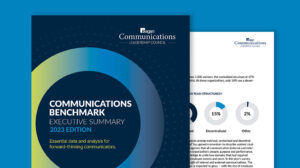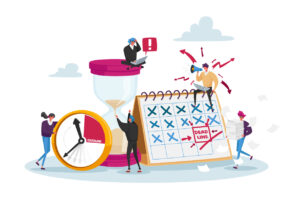6 steps to humanize, personalize and maximize your employee comms
Blasting out the same generic message to everyone won’t cut it anymore. Here’s how to craft content that’ll resonate with your diverse, unique workforce.

Global health and environmental issues, social movements and the evolving characteristics of rising generations continue to shift the way we organize, perceive and define our workplaces.
But when it comes to internal communications, leading with a human-centered approach remains essential for successful employee engagement. That means tailoring communications to individual employees and delivering personalized and empathetic content to the right person, at the right time, and on the platform of their choice. Sounds simple enough, right?
Here’s the catch – there is no one-size-fits-all plan. Every company’s program will look a bit different because each workforce is unique – varying in makeup of backgrounds, needs, values, priorities, challenges, goals and more. But as a starting point for getting your program off the ground, let’s walk through some vital steps to keep in mind as you build and maintain a framework for employee-centric internal communications.
1. Get to know your employees.
Blanket-style messages are often ineffective because they don’t consider the individual on the receiving end and often feel generic and irrelevant. Just like any other marketing communications effort, a strong understanding of the audience is a crucial first step to delivering communications that are engaged with instead of filed away and forgotten. Your strategy should be built around employees’ specific needs, particularly when it comes to format and delivery.
Here are some tried-and-true tactics for gathering the in-depth audience information you’ll need to get started:
- Dig into your data. Start with any existing data on your employee base and use it to piece together a high-level look at your company’s demographics. Based on common identifiers like location, role, and tenure begin to identify common employee groups.
- Survey employees. Send out a survey, or a series of small surveys, to gather more personalized information straight from the source. Include questions about their schedule, work environment, communications channel preferences, as well as more values-based questions around their stressors, motivators, and goals. Combine the information you gather to break down your high-level, demographics-based employee groups into even more specific circles.
- Build personas. Now that you have a better idea of the smaller cohorts develop a persona for each. A persona is essentially an in-depth profile of a fictional individual representing a segment of your target audience. Having these on hand as a resource will enable you to more accurately put yourself in your employees’ shoes to determine the best way to reach them.
- Develop employee journey maps. As employees transition through various career stages and their needs and priorities evolve, so must your communications to them. Build a journey for each of your personas – from onboarding through exit – to get a grasp on the essential moments and milestones that will affect your communications strategy.
2. Segment and tailor your messaging.
Marketers have been segmenting their communications to their target audiences to drive better engagement for ages. HubSpot reports that marketers who used segmented campaigns saw as much as a 760% increase in revenue from email alone. The same concept applies to an internal employee audience. Adjusting what each of your audience segments receives, when they receive it, and how they receive it certainly takes a bit of extra legwork. But the assurance that your employees are more likely to digest the information is worth it.
In addition to segmenting based on your personas, don’t forget to consider some of the more general factors that will dictate the type of information you want to provide and your schedule for sending:
- Geographic location. Ensure your correspondence is reaching them during their regular office hours in their time zone.
- Division or department. Only include what’s relevant to their area and focus within the company.
- Employee stage. Between entry-level and executive roles, the information needed will vary widely.
3. Recapture the magic of person-to-person conversations.
Your employees want to hear from a person, not a robot, so focus on making messages feel conversational. Think about how you would communicate the information to each specific employee group in person. Here are some of the top rules of engagement:
- Keep it casual. Avoid jargon and overly formal language. Instead, let some personality shine through to make the experience more authentic.
- Make it memorable. Be respectful of their time by getting straight to the point. Highlight the most important information and how it will directly affect the reader first.
- Be clear. Don’t assume people will fill in the blanks. Make sure to precisely state the need-to-knows.
4. Expand your comms channels.
We don’t need to tell you how overloaded inboxes are, and video calls are burning people out. Experiment with alternatives to give your employees a break from overused channels, and offer more flexibility in how and when they consume the information:
- Video content. There’s a reason TikTok took off. In fact, 72% of people would rather use video to learn about a product or service. People are drawn to short-form video content because it’s a quick, easy, and entertaining way to consume information.
- Podcasting. Podcasts continue to grow in popularity, with 78% of the total U.S. population aware of the medium and 41% considered monthly podcast listeners. uStudio, which specializes in SaaS for internal enterprise podcasting, found that pivoting to audio increases a brand’s ability to convey meaning and emotions by 500%, which has a greater impact on fostering connections with your employees.
- Visual elements. Research suggests that people are more likely to remember and learn content seen in images than in text. Across your channels, leverage more graphics-based formats, such as data visualizations and infographics. When communicating via email, consider designed templates that incorporate visuals or tools like Axios HQ, which filters information into a more easily digestible newsletter format.
- Live chats. Host a live Q&A or panel discussion that brings your employees into the conversation and enables you to gather real-time reactions and feedback. Be sure to record and make available for employees who are unable attend.
- Mobile-first options. Some workforces include staff that are out in the field all day instead of glued to a computer screen. Consider solutions that can keep these often deskless employees connected, such as a mobile app and text messaging. Podcasting works here too.
- In-person interaction. While in-person gatherings are far less common than they once were before the COVID-19 pandemic, it’s hard to deny the power of having a conversation face-to-face. When possible – and safe – schedule time to physically sit down with individuals or groups to forge important bonds more personally.
5. Consistently measure and analyze key metrics.
As you begin to deploy a range of communications tactics, be sure to continually audit your new and existing channels using a combination of quantitative (statistical analysis) and qualitative analysis (focus groups, interviews, and observations) to find out what’s working and what’s not. You can then use this information to adjust campaigns and strategies in near real-time, increasing the likelihood that you’re sending content that employees want when they are most likely to engage.
Start by getting a robust measurement and analysis program in place, including identifying specific goals and objectives for your employee communications program. Then, figure out what data you have and what data you need, as well as the necessary tools to gather that missing information. From there, measure, analyze, and adjust your program continuously for optimal results. Internal communications platform, Social Chorus, offers smart advice on how to do this, including how often to pull and analyze results.
6. Stay flexible and open to change.
With the pace of work and information sharing growing continuously, it’s getting harder and harder to get employees’ attention. Considering this environment, you can’t get too comfortable even if you feel your program has found its groove. To maintain personalized communications, you must continue to revisit and tweak your personas, segmentation, and outreach strategies to stay on top of your employees’ current needs and preferences. Managed carefully, you’ll find yourself with a more connected and aligned workforce and one step closer to delivering a stronger overall employee experience.
Starr Million Baker is the CEO and co-founder of INK Communications. Read more on INK’s blog.






